Community engagement has always been an essential part of the medical student experience here at WUSM. Students have worked with a variety of organizations focused on helping many different populations, including the uninsured, victims of trauma, youth, and many more. In order to better serve those populations and the larger community, the way in which we engage with them is undergoing an evolution. Here are some of the ideas and visions, contributed by both leadership and students, our institution hopes to implement and achieve as we strive to be in St. Louis, for St. Louis.
Cover photo: Dr. Punch leads a Community Engagement curriculum planning meeting.
A Letter from Washington University Chancellor Andrew D. Martin
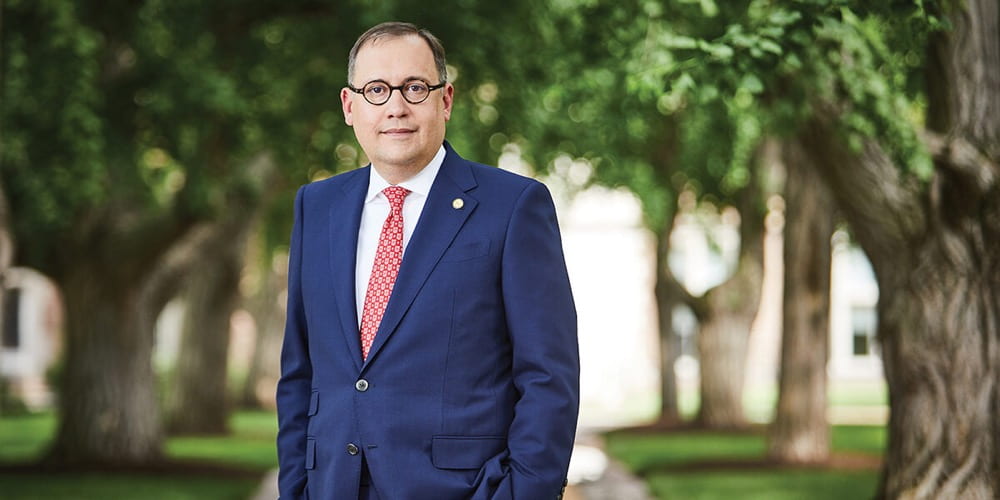
Chancellor Andrew D. Martin
When students and faculty at Washington University School of Medicine share their “Why WashU” stories, they often cite our uniquely supportive community. Here at WUSM, you’ll meet friends and mentors who will cheer for your success, look out for your personal well-being, and over time, become like family. But as we seek to make the most impact, I’m calling us to expand our definition of community beyond our university relationships – to be “Washington University In St. Louis, For St. Louis.” This means extending our values of excellence in education, research, and patient care into the broader community, doing the most good for all St. Louisans.
St. Louis is often called a “hidden gem” of a city, with eclectic restaurant offerings, a lively arts culture, inspiring architecture, and a “hopping” craft brewery scene. Tragically, though, we also have segregation, housing concerns, malnutrition, and gun violence. We have educational, income, and health inequalities that are unacceptable. By choosing to study at WUSM, you have a unique opportunity to enjoy one of the world’s great cities while helping to solve some of the world’s most pressing social challenges, starting with our closest municipalities and neighborhoods. As a university, it’s our moral imperative to show up for this community; so, too, are we strengthened by seizing that opportunity. This city, our university, and our people must grow together.
At WUSM, you’ll have opportunities to work alongside globally-renowned leaders from all facets of the university to address health disparities and improve the well-being of some of our most vulnerable populations. You’ll work to build synergy with a diverse array of dedicated researchers to create promising solutions to problems that have remained unsolved for far too long. When we are “In St. Louis, For St. Louis” and find science-based interventions that work here at home, those interventions can be applied in other communities around the world.
And when you do it alongside those who are equally committed … well, that’s when “community” becomes transformative. That’s our “WashU Compact,” and I look forward to seeing the contributions you’ll make during your time here.
A Letter from Laurie Punch, MD, and Audrey Coolman, MPH
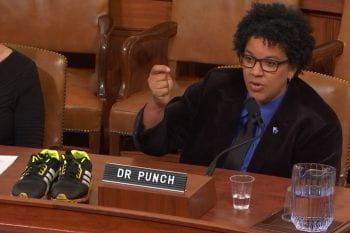
Dr. Laurie Punch testifies before the House Ways and Means Oversight Committee. Photo credit: YouTube.
Health equity is an elusive and still urgent goal in the modern practice of medicine. Health is largely determined by where we live, work, learn, and recreate. Effective health care requires an active understanding of these determinants of health and the ability to navigate the complexity of health care systems to deliver that care. The new Gateway Curriculum seeks to provide students with opportunities to gain those skills of navigation, or structural competency in medicine, through an integrated approach which includes social, clinical and basic sciences. This competency requires an understanding of both the internal and external communities which drive health care, including professionals from many different disciplines and people with a diverse range of identities and experiences.
Community engagement within the Gateway Curriculum is being structured to allow students deep understanding and lived experience in social and structural determinants of health. Led by faculty champions, small groups of students within the Gateway Curriculum will progress through stages of community engagement, in partnership with organizations, to address one of the key community health needs. Community partnerships in research will be another featured element of the experience.
Well beyond the scope of service learning, this longitudinal exploration of social and structural determinants of health will allow students to truly grapple with the forces driving health inequity. Through aligned and longitudinal work, the student body will be positioned to impact health outcomes in the St. Louis region where there is greatest need. While this content represents a challenging body of knowledge, students will be given time and space to deconstruct these concepts to better understand the St. Louis region that they will serve throughout their medical education. This robust community engagement curriculum will help address the identified needs of the St. Louis region throughout all three phases of medical education. Washington University School of Medicine is in St. Louis, for St. Louis, an experience which will prepare students for ongoing community engagement, wherever their career trajectory may lead.
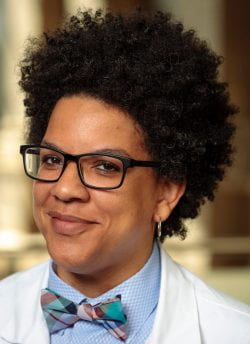 Dr. Laurie Punch is an Associate Professor of Surgery in the Division of General Surgery (Acute and Critical Care Surgery Section). Beyond their contributions as a trauma surgeon at Washington University School of Medicine, Dr. Punch is a community leader, the founder of the St. Louis Stop the Bleed program and The T AntiViolence Center, and a nationally-recognized gun violence expert. Check out their recent talk at TEDxGatewayArch.
Dr. Laurie Punch is an Associate Professor of Surgery in the Division of General Surgery (Acute and Critical Care Surgery Section). Beyond their contributions as a trauma surgeon at Washington University School of Medicine, Dr. Punch is a community leader, the founder of the St. Louis Stop the Bleed program and The T AntiViolence Center, and a nationally-recognized gun violence expert. Check out their recent talk at TEDxGatewayArch.
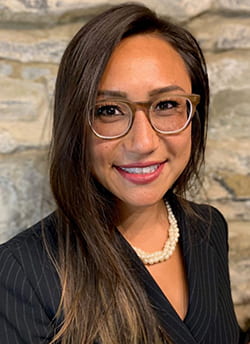 Audrey Coolman is the Community Service Learning Project Manager for WUSM and has been integral to developing the Community Engagement aspects of the Gateway Curriculum.
Audrey Coolman is the Community Service Learning Project Manager for WUSM and has been integral to developing the Community Engagement aspects of the Gateway Curriculum.
Community Engagement, Now and Later
Aaron Guo (M1) and Anthony Wang (M1)

Anthony Wang (left) and Aaron Guo, both M1 students
If you haven’t already, the Delmar Divide is something that you will certainly hear about during your time in St. Louis. Delmar Boulevard is a physical landmark that represents the complex history of St. Louis — a city filled with rich culture yet marred by racial division and inequality. This difficult past carries profound consequences on St. Louis communities, in particular health care and medical access. Although the disparity in health care is a result of several factors, like socioeconomic status and local geography, social and structural determinants of health have left communities uncared for and unheard.
In the face of such foundational barriers, local organizations and institutions have manifested to offer a chance for the underserved. In our first weeks of school, WashU acknowledged and educated us on the scarred city landscape, motivating many of us to use our education, training, and privilege, to make a difference. As a volunteer and coordinator for the Saturday Neighborhood Health Clinic (SNHC), WashU’s student-led free clinic, we witnessed firsthand the medical impacts of St. Louis’s dark past on present St. Louis patients. As WUSM medical students, volunteering at the clinic offers not just an opportunity to practice clinical skills on real patients, but more importantly be part of a team that provides medical care for the uninsured. As clinic coordinators, we learned to lead and manage clinic operations and connect patients to community organizations and primary care providers that offer affordable longitudinal care. Ultimately, however, free clinics such as SNHC are only a bandage in the process of healing St. Louis.
In response to these inequities, WUSM has committed on an institutional level to increasing and improving medical student involvement in the community via the community engagement curriculum, one column of the upcoming Gateway Curriculum. Led by trauma surgeon and anti-violence community leader Dr. Laurie Punch, this new curriculum integrates community-based learning longitudinally throughout the pre-clinical and clinical phases and aims to teach students how to engage constructively and responsibly in St. Louis. Just as importantly, this curriculum aims to connect dozens of community organizations with missions ranging from health care access to food insecurity to violence. After learning from experts in the field about the various health care obstacles that St. Louis faces, first year students will leave the classroom to actively work with partnered community organizations on a socioeconomic topic that caters to individual interests. Ultimately, we hope that even as a student, you can begin to meaningfully contribute to the improvement of communities in the city of St. Louis. Social determinants of health — the ways we live, work, and play — account for over 80% of health outcomes, and as medical students in the Gateway Curriculum, you will learn not only how to serve patients in the hospital, but outside of it as well.
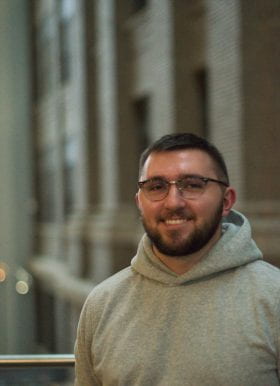
Lane Parmely
In St. Louis, for St. Louis Section Editor
My name is Lane, and I’m a first-year medical student here at WashU. I’m from rural Tennessee. I graduated in 2017 from Austin Peay State University (Let’s Go Peay!) with a degree in chemistry. I then got my master’s degree from The University of Mississippi, where I worked in a biophysical chemistry research lab. I’m excited to continue my research training here at WashU. When I’m not studying, I enjoy spending time hanging out with friends in The Grove.